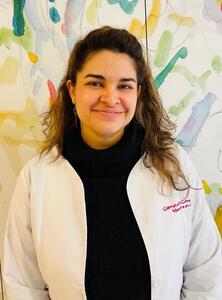Group leader: Annalisa Buffo


Gabriela Berenice Gómez-González
Contacts:
Education
2016 – 2020. PhD Biomedical Sciences (Summa cum laude: “Mención Honorífica”). Institute of Neurobiology, UNAM, México. PI: Dr. Ataúlfo Martínez Torres.
Thesis Project: Anatomical characterization of the neuronal circuit from the subventricular zone in the mouse cerebellum.
2015-2016. Research stay fellow: Laboratory of Neuro-glia pharmacology, University of Regensburg, PI: Dr. Barbara DiBenedetto. German Federal Ministry of Education and Research (BMBF), Germany.
2012 – 2014. Master Science Neurobiology (Summa cum laude: “Mención Honorífica”). Institute of Neurobiology, UNAM, Mexico. PI: Dr. Ataúlfo Martinez-Torres.
Thesis Project: Morphological characterization of Bergmann Glia from X lobule of the mouse cerebellum.
2011 (june-july). Research Internship Grant. TUFTS Medical Center, Diabetes and endocrinology laboratory, Boston, USA. PI: M.D. Ronald Lechan. Given by the Universidad Autonoma de Morelos, Mexico.
2007 – 2012. Bachelor degree in Biology (Summa cum laude: “Mención Honorífica”). Faculty of Biological Sciences, UAEM, Morelos, Mexico. PI: Dr. Edith Sánchez Jaramillo.
Thesis Project: Characterization of a pTRH-Cre transgenic mouse: Cre expression in the PVN of Hypothalamus in animals stressed by cool or starvation.
Current position
Post-doc Fellow, Department of Neuroscience Rita Levi Montalcini and Neuroscience Institute Cavalieri Ottolenghi (NICO), University of Turin, Italy. PI: Prof. Annalisa Buffo
Scientific interest
The project in which I’m involved has the aim to assess the functional and anatomical integration of the medium spiny neurons(hMSN) derived from human embryonic stem cells (hESC) in a rat model of Huntington’s disease, to understand the contribution of those cells in the recovery of motor functions. For these purposes, we are employing and stablishing technical approaches as photometry and optogenetic, including the use of specific tracers and viral tools. This project take part of a EU Consortium (NSC-Reconstruction), in which the final aim is to develop basic/applied knowledge that later can be translated in human cell therapies.
Role in research
Responsible of the functional assessing of the hESC grafts.
Publications:
>
PubMed.gov
>
ORCID






